Fatigue–Creep Interaction of P92 Steel and Modified Constitutive Modelling for Simulation of the Responses
Abstract
:1. Introduction
2. Material, Specimens and Experiments
3. Experimental Observations
3.1. Dwell Time Effect
3.2. Temperature Effect
3.3. Strain Range Effect
4. Unified Viscoplastic Constitutive Model
4.1. Conventional Chaboche Model
4.2. Simulation Capability of the Conventional Chaboche Model
4.3. Modification of Constitutive Model
4.3.1. Modification of the Kinematic Hardening Rule
4.3.2. Modification of the Isotropic Hardening Rule
5. Determination of Material Parameters
6. Simulation and Discussion
6.1. Simulation of Fatigue–Creep Responses at 600 °C
6.2. Simulation of Fatigue–Creep Loading at 650 °C
6.3. Simulation of Fatigue–Creep Responses for Different Strain Ranges
7. Conclusions
Author Contributions
Funding
Conflicts of Interest
References
- Li, M.; Barrett, R.A.; Scully, S.; Harrison, N.M.; Leen, S.B.; O’Donoghue, P.E. Cyclic plasticity of welded P91 material for simple and complex power plant connections. Int. J. Fatigue 2016, 87, 391–404. [Google Scholar] [CrossRef] [Green Version]
- Farragher, T.P.; Scully, S.; O’Dowd, N.P.; Leen, S.B. Development of life assessment procedures for power plant headers operated under flexible loading scenarios. Int. J. Fatigue 2013, 49, 50–61. [Google Scholar] [CrossRef]
- Viswanathan, R.; Henry, J.F.; Tanzosh, J.; Stanko, G.; Shingledecker, J.; Vitalis, B.; Purgert, R.U.S. program on materials technology for ultra-supercritical coal power plants. J. Mater. Eng. Perform. 2005, 14, 281–292. [Google Scholar] [CrossRef]
- Swindeman, R.W.; Santella, M.L.; Maziasz, P.J.; Roberts, B.W.; Coleman, K. Issues in replacing Cr–Mo steels and stainless steels with 9Cr–1Mo–V steel. Int. J. Press. Vessels Pip. 2004, 81, 507–512. [Google Scholar] [CrossRef]
- Zhang, W.; Wang, X.W.; Li, X.; Gong, J.M.; Wahab, M.A. Influence of prior low cycle fatigue on microstructure evolution and subsequent creep behavior. Int. J. Fatigue 2018, 109, 114–125. [Google Scholar] [CrossRef]
- Mannan, S.L.; Valsan, M. High-temperature low cycle fatigue, creep–fatigue and thermomechanical fatigue of steels and their welds. Int. J. Mech. Sci. 2006, 48, 160–175. [Google Scholar] [CrossRef]
- Sakasegawa, H.; Hirose, T.; Kohyama, A.; Katoh, Y.; Harada, T.; Asakura, K. Microstructural stability of reduced activation ferritic/martensitic steels under high temperature and stress cycling. Fusion Eng. Des. 2002, 61–62, 671–675. [Google Scholar] [CrossRef]
- Vaillant, J.C.; Vandenberghe, B.; Hahn, B.; Heuser, H.; Jochum, C. T/P23, 24, 911 and 92: New grades for advanced coal-fired power plants—Properties and experience. Int. J. Press. Vessels Pip. 2008, 85, 38–46. [Google Scholar] [CrossRef]
- Islam, N.; Dewees, D.; Hassan, T. Unified Viscoplasticity Modeling Features Needed for Simulation of Grade 91 Creep and Fatigue Responses. In Proceedings of the ASME 2016 Pressure Vessels and Piping Conference, Vancouver, BC, Canada, 17–21 July 2016. [Google Scholar]
- Fournier, B.; Sauzay, M.; Caës, C.; Noblecourt, M.; Mottot, M.; Bougault, A.; Rabeau, V.; Pineau, A. Creep–fatigue–oxidation interactions in a 9Cr–1Mo martensitic steel. Part I: Effect of tensile holding period on fatigue lifetime. Int. J. Fatigue 2008, 30, 649–662. [Google Scholar] [CrossRef]
- Chen, X.; Sokolov, M.A.; Sham, S.; Erdman, D.L.; Busby, J.T.; Mo, K.; Stubbins, J.F. Experimental and modeling results of creep–fatigue life of Inconel 617 and Haynes 230 at 850 °C. J. Nucl. Mater. 2013, 432, 94–101. [Google Scholar] [CrossRef]
- Srinivasan, V.S.; Nagesha, A.; Valsan, M.; Rao, K.B.S.; Mannan, S.L.; Sastry, D.H. Effect of hold-time on low cycle fatigue behaviour of nitrogen bearing 316L stainless steel. Int. J. Press. Vessels Pip. 1999, 76, 863–870. [Google Scholar] [CrossRef]
- Shankar, V.; Mariappan, K.; Sandhya, R.; Laha, K.; Bhaduri, A.K. Long term creep-fatigue interaction studies on India-specific reduced activation ferritic-martensitic (IN-RAFM) steel. Int. J. Fatigue 2017, 98, 259–268. [Google Scholar] [CrossRef]
- Barrett, P.R.; Ahmed, R.; Menon, M.; Hassan, T. Isothermal low-cycle fatigue and fatigue-creep of Haynes 230. Int. J. Solids Struct. 2016, 88–89, 146–164. [Google Scholar] [CrossRef]
- Zhang, S.; Xuan, F.Z. Interaction of cyclic softening and stress relaxation of 9–12% Cr steel under strain-controlled fatigue-creep condition: Experimental and modeling. Int. J. Plast. 2017, 98, 45–64. [Google Scholar] [CrossRef]
- Wang, X.W.; Zhang, W.; Gong, J.M.; Jiang, Y. Experimental and numerical characterization of low cycle fatigue and creep fatigue behaviour of P92 steel welded joint. Fatigue Fract. Eng. Mater. Struct. 2018, 41, 611–624. [Google Scholar] [CrossRef]
- Chaboche, J.L.; Rousselier, G. On the Plastic and Viscoplastic Constitutive Equations—Part I: Rules Developed With Internal Variable Concept. J. Press. Vessel Technol. 1983, 105, 153–158. [Google Scholar] [CrossRef]
- Chaboche, J.L. Constitutive equations for cyclic plasticity and cyclic viscoplasticity. Int. J. Plast. 1989, 5, 247–302. [Google Scholar] [CrossRef]
- Yaguchi, M.; Takahashi, Y. A viscoplastic constitutive model incorporating dynamic strain aging effect during cyclic deformation conditions. Int. J. Plast. 2000, 16, 241–262. [Google Scholar] [CrossRef]
- Kang, G.Z.; Gao, Q.; Yang, X.J. A visco–plastic constitutive model incorporated with cyclic hardening for uniaxial/multiaxial ratcheting of SS304 stainless steel at room temperature. Mech. Mater. 2002, 34, 521–531. [Google Scholar] [CrossRef]
- Yang, X.J. A viscoplastic model for 316L stainless steel under uniaxial cyclic straining and stressing at room temperature. Mech. Mater. 2004, 36, 1073–1086. [Google Scholar] [CrossRef]
- Krishna, S.; Hassan, T.; Naceur, I.B.; Sai, K.; Cailletaud, G. Macro Versus Micro Scale Cyclic Plasticity Models in Simulating Nonproportional Cyclic and Ratcheting Responses of Stainless Steel 304. Int. J. Plast. 2009, 25, 1910–1949. [Google Scholar] [CrossRef]
- Ahmed, R.; Barrett, P.R.; Hassan, T. Unified viscoplasticity modeling for isothermal low-cycle fatigue and fatigue-creep stress–strain responses of Haynes 230. Int. J. Solids Struct. 2016, 88–89, 131–145. [Google Scholar] [CrossRef]
- Zhou, J.; Sun, Z.; Kanouté, P.; Retraint, D. Experimental analysis and constitutive modelling of cyclic behaviour of 316L steels including hardening/softening and strain range memory effect in LCF regime. Int. J. Plast. 2018, 107, 54–78. [Google Scholar] [CrossRef]
- Yaguchi, M.; Takahashi, Y. Ratchetting of viscoplastic material with cyclic softening, part 2: Application of constitutive models. Int. J. Plast. 2005, 21, 835–860. [Google Scholar] [CrossRef]
- Kan, Q.H.; Kang, G.Z.; Zhang, J. Uniaxial time-dependent ratchetting: Visco-plastic model and finite element application. Theor. Appl. Fract. Mech. 2007, 47, 133–144. [Google Scholar] [CrossRef]
- Chen, W.; Kitamura, T.; Feng, M. Creep and fatigue behavior of 316L stainless steel at room temperature: Experiments and a revisit of a unified viscoplasticity model. Int. J. Fatigue 2018, 112, 70–77. [Google Scholar] [CrossRef]
- Alsmadi, Z.Y.; Alomari, A.; Kumar, N.; Murty, K.L. Effect of hold time on high temperature creep-fatigue behavior of Fe–25Ni–20Cr (wt.%) austenitic stainless steel (Alloy 709). Mater. Sci. Eng. A 2020, 771, 138591. [Google Scholar] [CrossRef]
- Zhang, W.; Wang, X.W.; Gong, J.M.; Jiang, Y.; Huang, X. Experimental and simulated characterization of creep behavior of P92 steel with prior cyclic loading damage. J. Mater. Sci. Technol. 2017, 33, 1540–1548. [Google Scholar] [CrossRef]
- Kimura, M.; Yamaguchi, K.; Hayakawa, M.; Kobayashi, K.; Kanazawa, K. Microstructures of creep-fatigued 9–12% Cr ferritic heat-resisting steels. Int. J. Fatigue 2006, 28, 300–308. [Google Scholar] [CrossRef]
- Wang, X.W.; Gong, J.M.; Zhao, Y.P.; Wang, Y.F.; Yu, M.H. Characterization of low cycle fatigue performance of new ferritic P92 steel at high temperature: Effect of strain amplitude. Steel Res. Int. 2015, 86, 1046–1055. [Google Scholar] [CrossRef]
- Wang, X.W.; Zhang, W.; Gong, J.M.; Wahab, M.A. Low cycle fatigue and creep fatigue interaction behavior of 9Cr-0.5 Mo-1.8 WV-Nb heat-resistant steel at high temperature. J. Nucl. Mater. 2018, 505, 73–84. [Google Scholar] [CrossRef]
- Lu, Y.L.; Chen, L.J.; Wang, G.Y.; Benson, M.L.; Liaw, P.K.; Thompson, S.A.; Blust, J.W.; Browning, P.F.; Bhattacharya, A.K.; Aurrecoechea, J.M.; et al. Hold time effects on low cycle fatigue behavior of HAYNES 230® superalloy at high temperatures. Mater. Sci. Eng. A 2005, 409, 282–291. [Google Scholar] [CrossRef]
- Jürgens, M.; Olbricht, J.; Fedelich, B.; Skrotzki, B. Low Cycle Fatigue and Relaxation Performance of Ferritic–Martensitic Grade P92 Steel. Metals 2019, 9, 99. [Google Scholar] [CrossRef] [Green Version]
- Chaboche, J.L. A review of some plasticity and viscoplasticity constitutive theories. Int. J. Plast. 2008, 24, 1642–1693. [Google Scholar] [CrossRef]
- Saad, A.A.; Hyde, T.H.; Sun, W.; Hyde, C.J. Characterization of viscoplasticity behaviour of P91 and P92 power plant steels. Int. J. Press. Vessels Pip. 2013, 111, 246–252. [Google Scholar] [CrossRef]
- Wang, X.W.; Jiang, Y.; Gong, J.M.; Zhao, Y.P.; Huang, X. Characterization of low cycle fatigue of ferritic–martensitic P92 steel: Effect of temperature. Steel Res. Int. 2016, 87, 761–771. [Google Scholar] [CrossRef]
- Nam, S.W. Assessment of damage and life prediction of austenitic stainless steel under high temperature creep–fatigue interaction condition. Mater. Sci. Eng. A 2002, 322, 64–72. [Google Scholar] [CrossRef]
- Yan, X.L.; Zhang, X.C.; Tu, S.T.; Mannan, S.L.; Xuan, F.Z.; Lin, Y.C. Review of creep–fatigue endurance and life prediction of 316 stainless steels. Int. J. Press. Vessels Pip. 2015, 126, 17–28. [Google Scholar] [CrossRef]
- Chaboche, J.L.; Nouailhas, D. A unified constitutive model for cyclic viscoplasticity and its applications to various stainless steels. J. Eng. Mater. Technol. 1989, 111, 424–430. [Google Scholar] [CrossRef]
- Ding, J.; Kang, G.Z.; Kan, Q.H.; Liu, Y.J. Constitutive model for uniaxial time-dependent ratcheting of 6061-T6 aluminum alloy. Comput. Mater. Sci. 2012, 57, 67–72. [Google Scholar] [CrossRef]
- Yaguchi, M.; Yamamoto, M.; Ogata, T. A viscoplastic constitutive model for nickel-base superalloy, part 1: Kinematic hardening rule of anisotropic dynamic recovery. Int. J. Plast. 2002, 18, 1083–1109. [Google Scholar] [CrossRef]
- Chaboche, J.L. Cyclic viscoplastic constitutive equations, part I: A thermodynamically consistent formulation. J. Appl. Mech. 1993, 60, 813–821. [Google Scholar] [CrossRef]
- Kyaw, S.T.; Rouse, J.P.; Lu, J.W.; Sun, W. Determination of material parameters for a unified viscoplasticity-damage model for a P91 power plant steel. Int. J. Mech. Sci. 2016, 115–116, 168–179. [Google Scholar] [CrossRef]
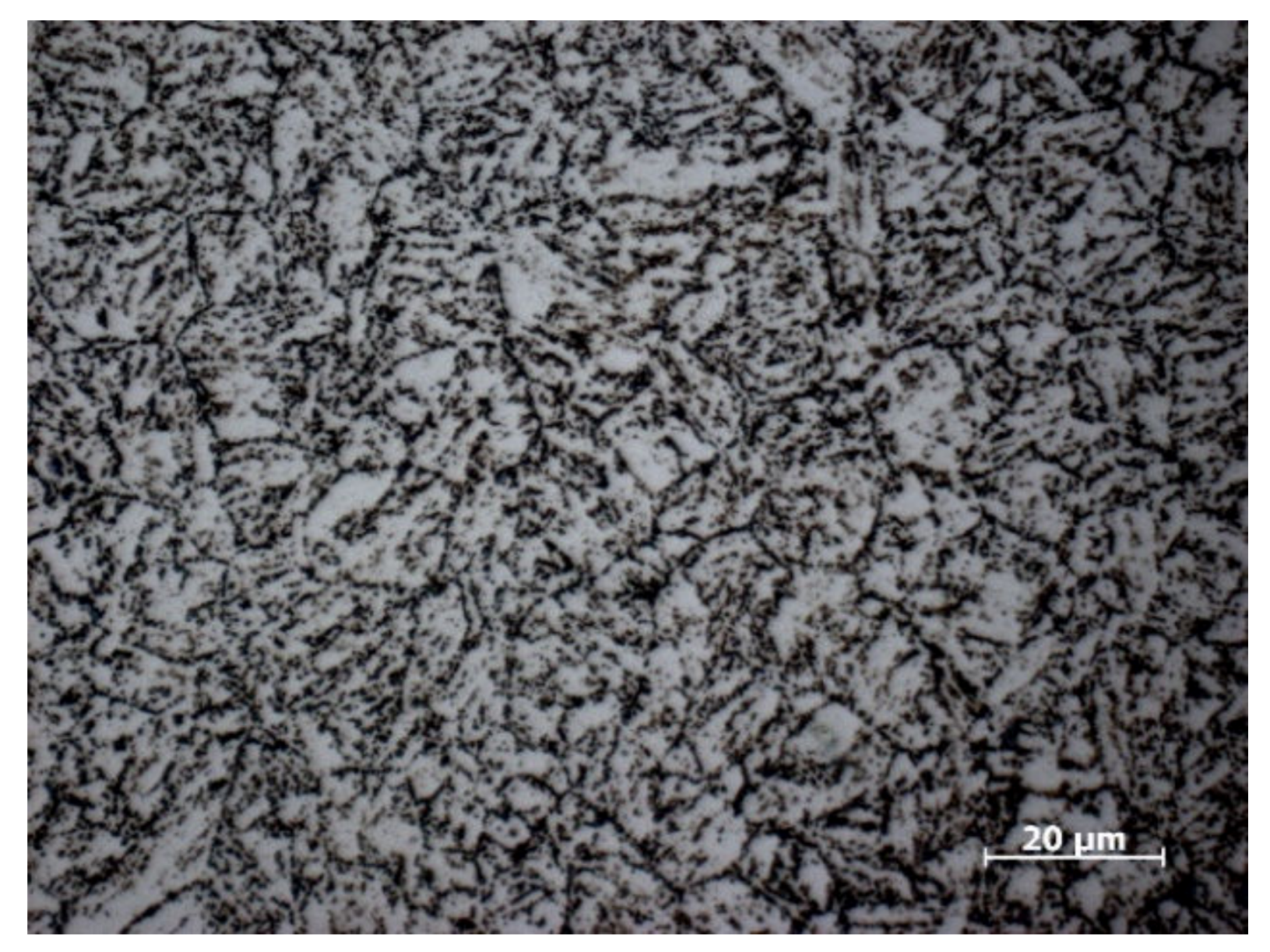
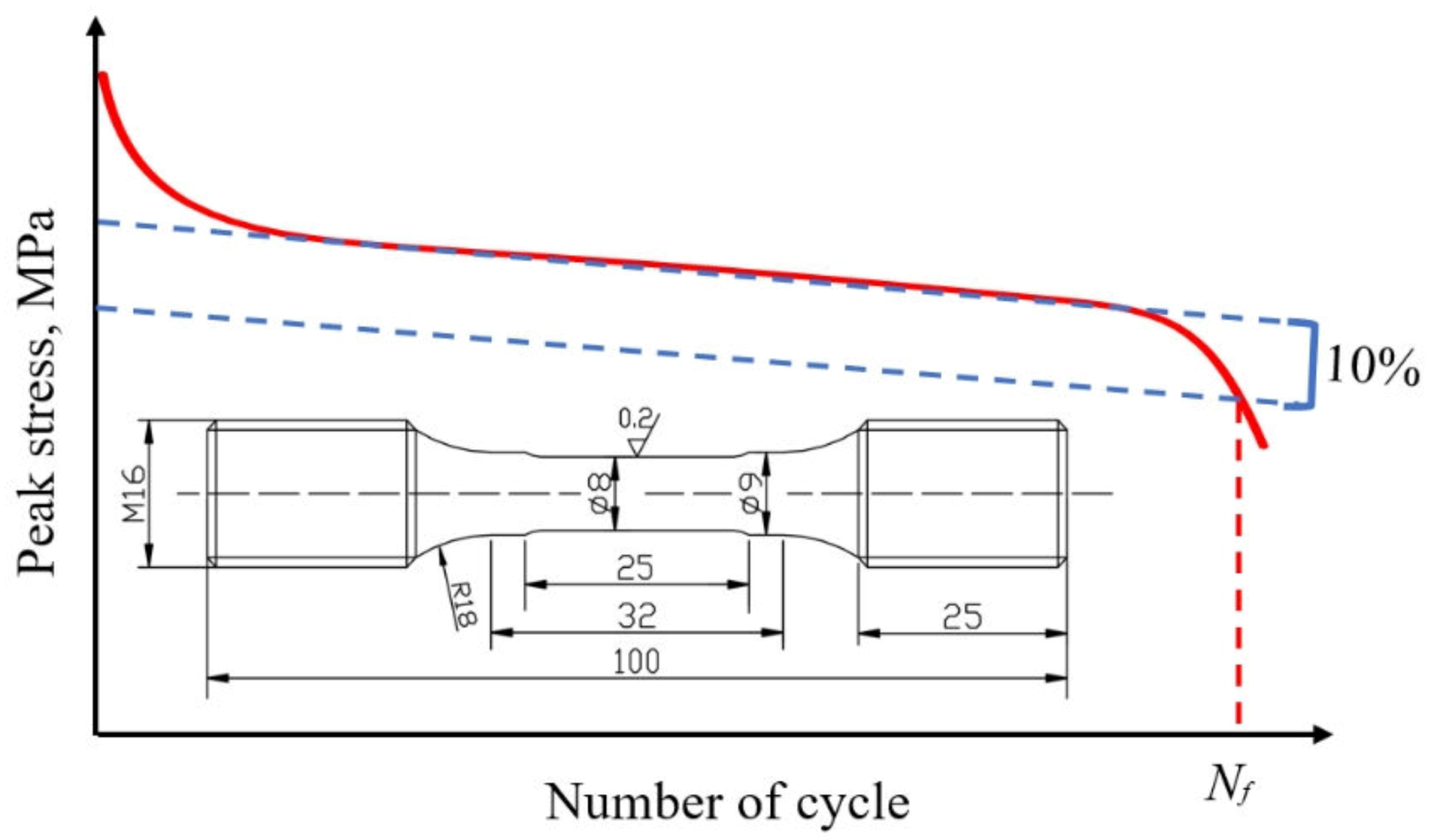
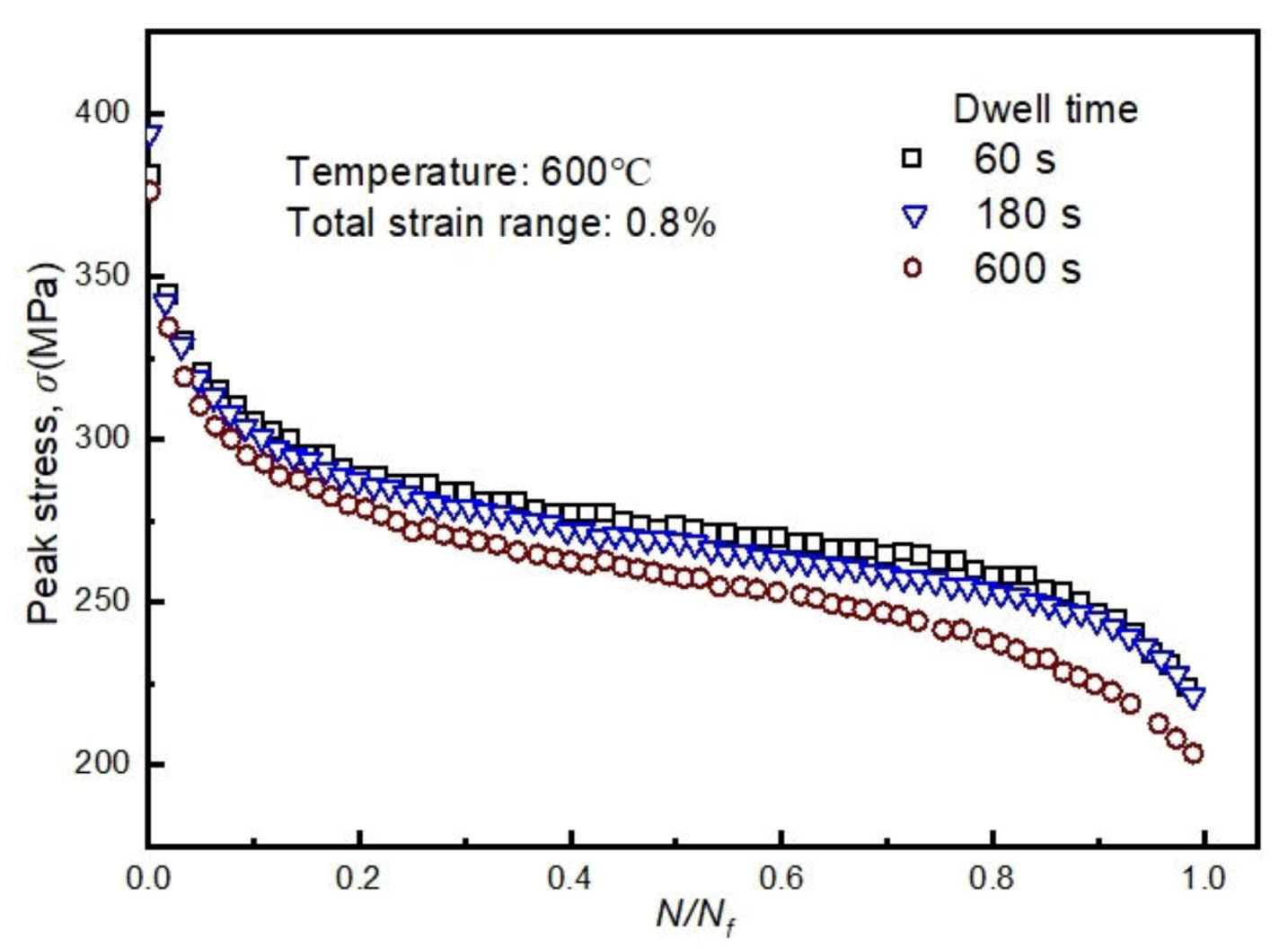
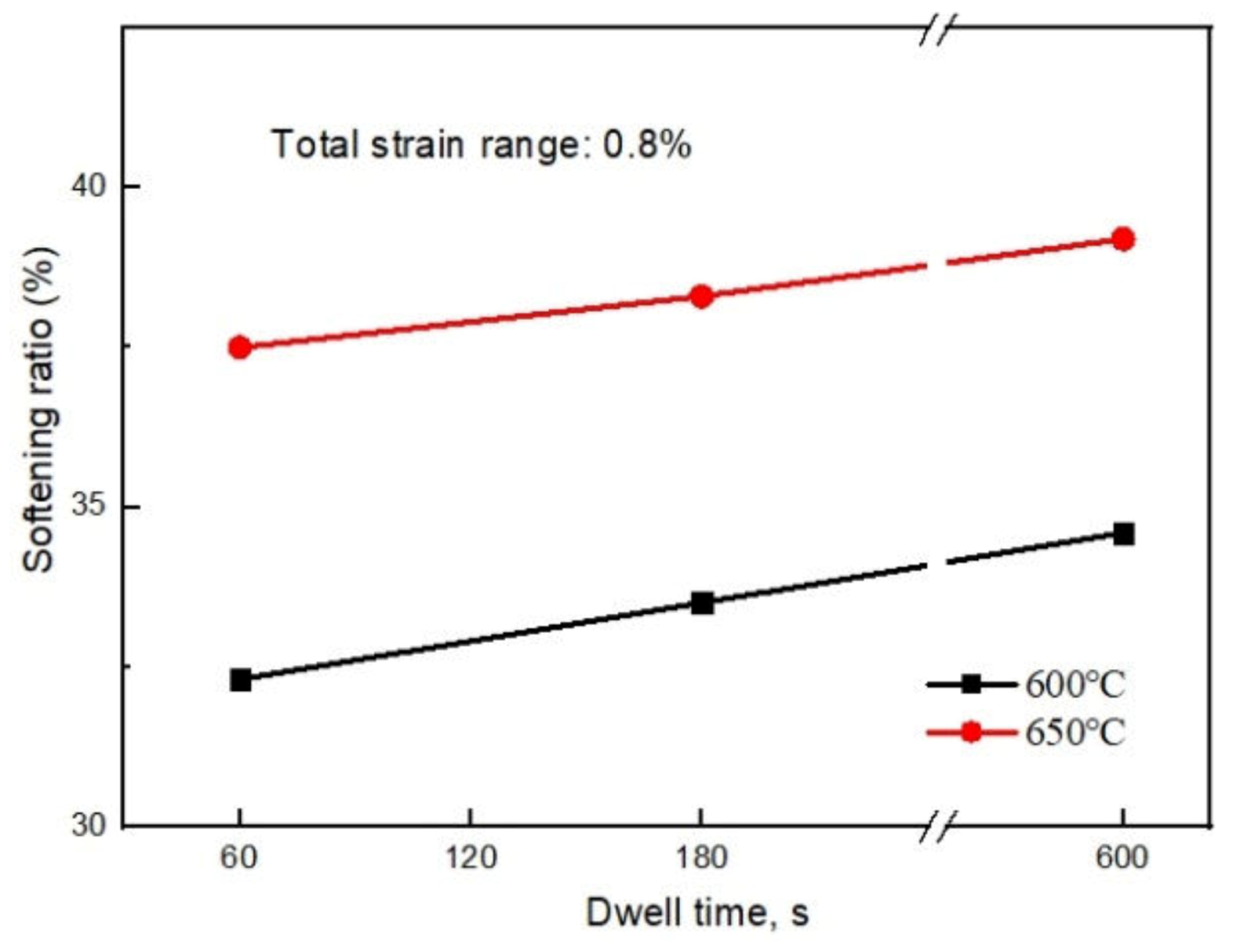

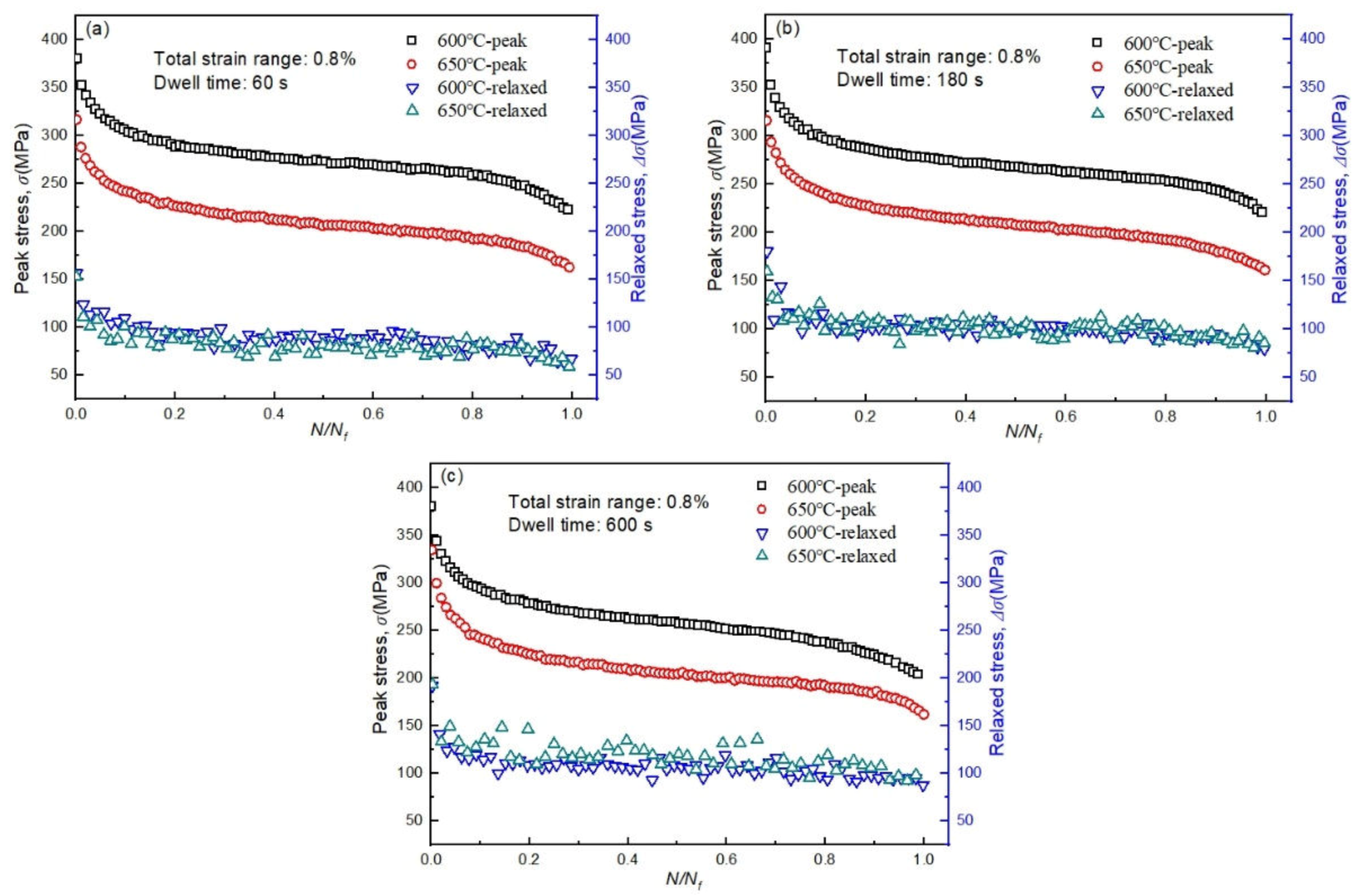
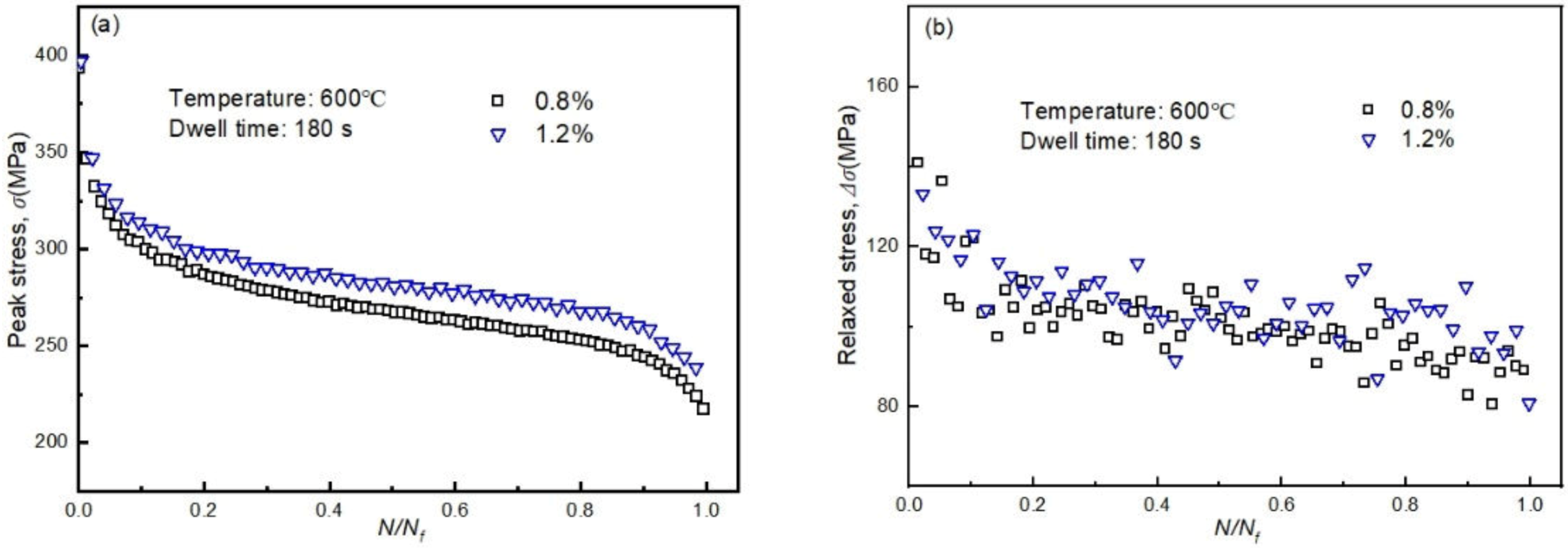
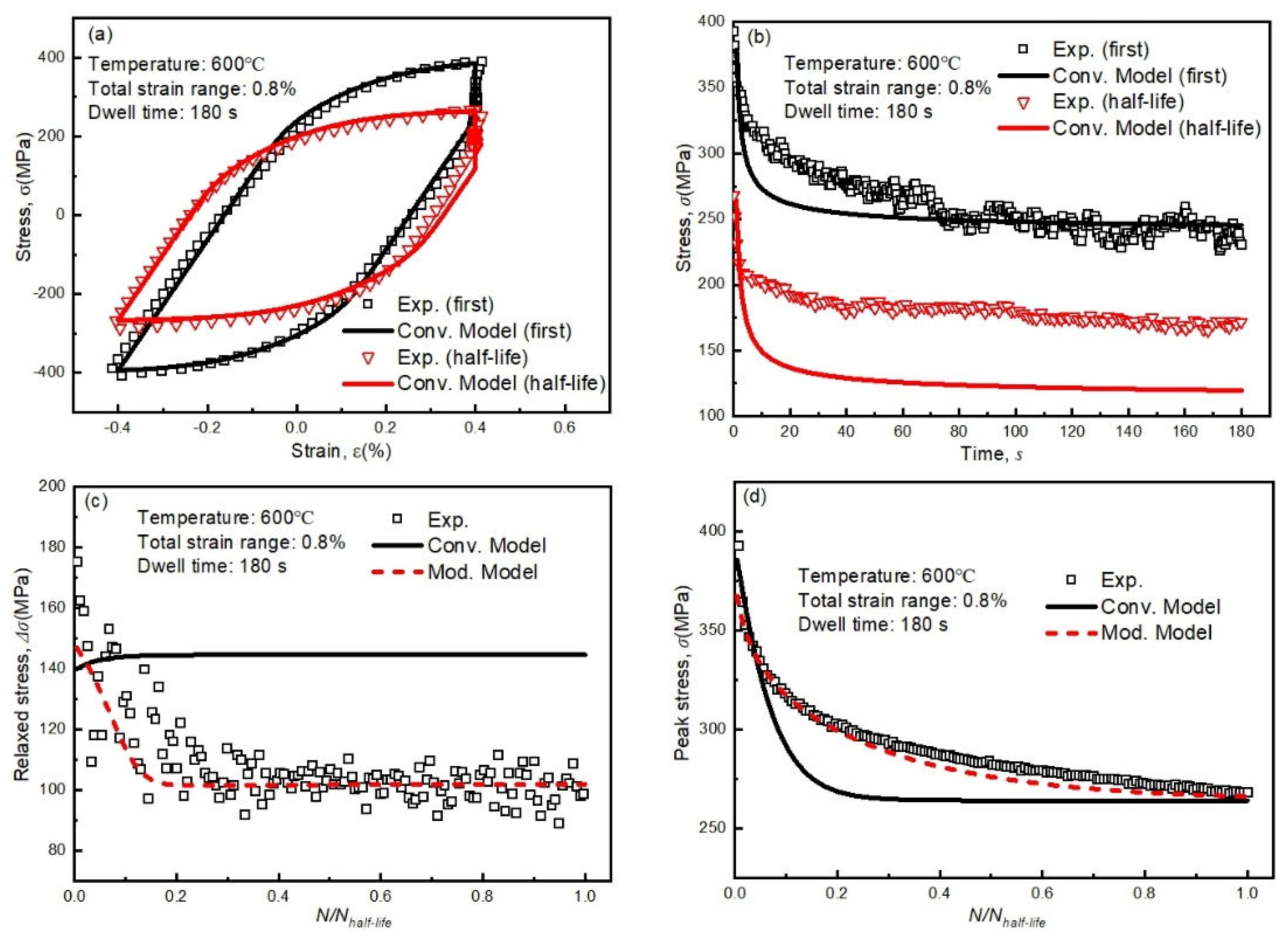
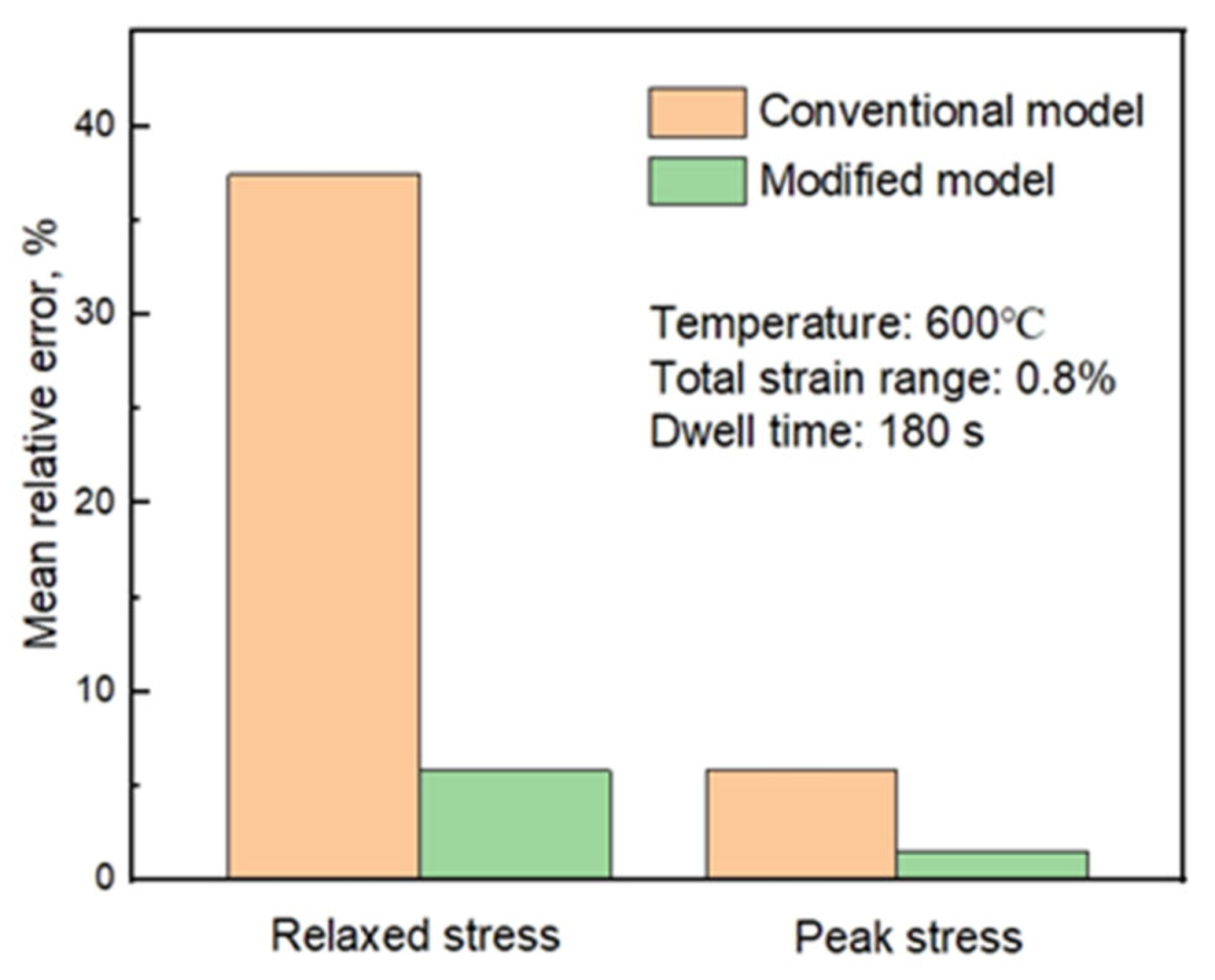

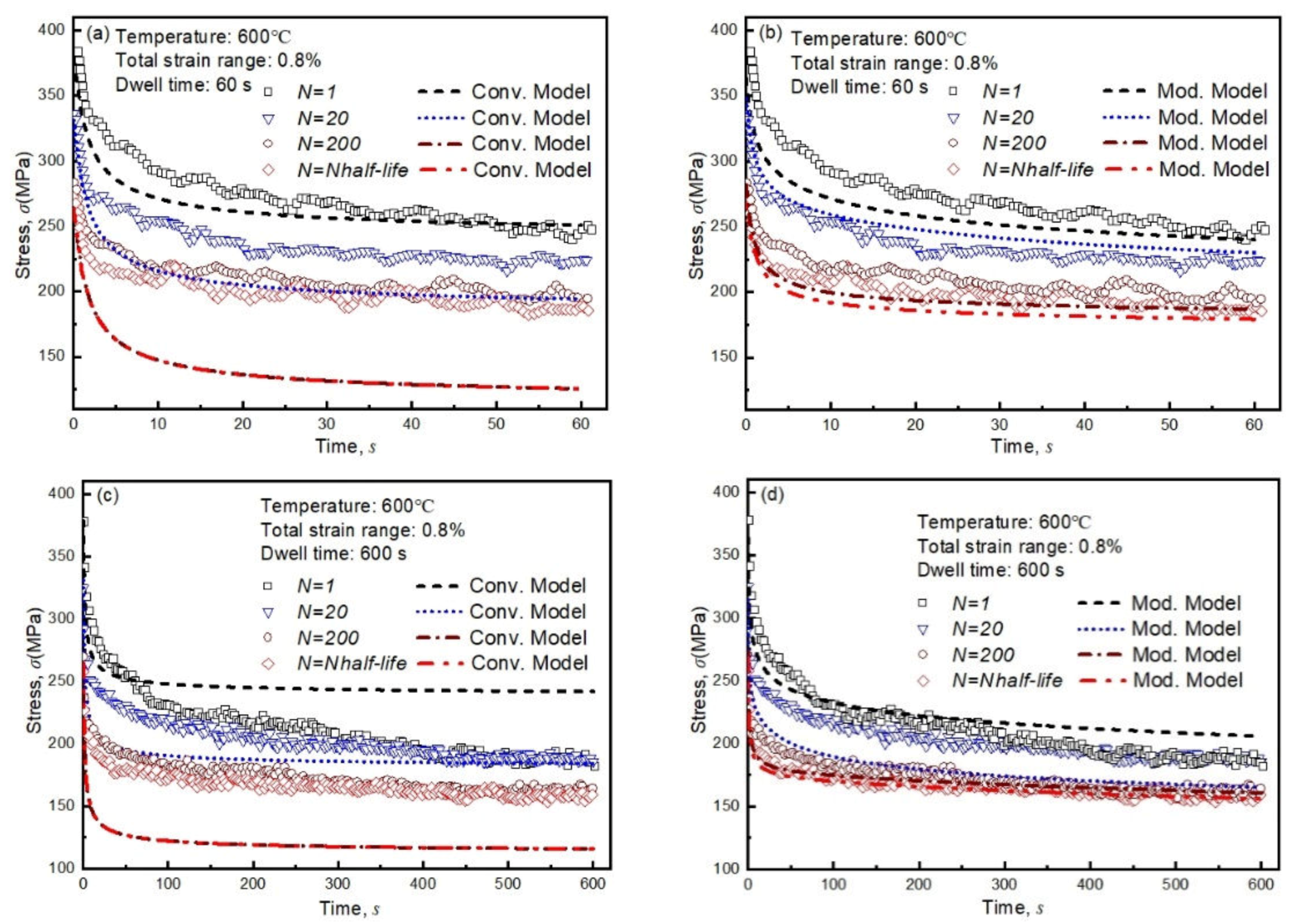
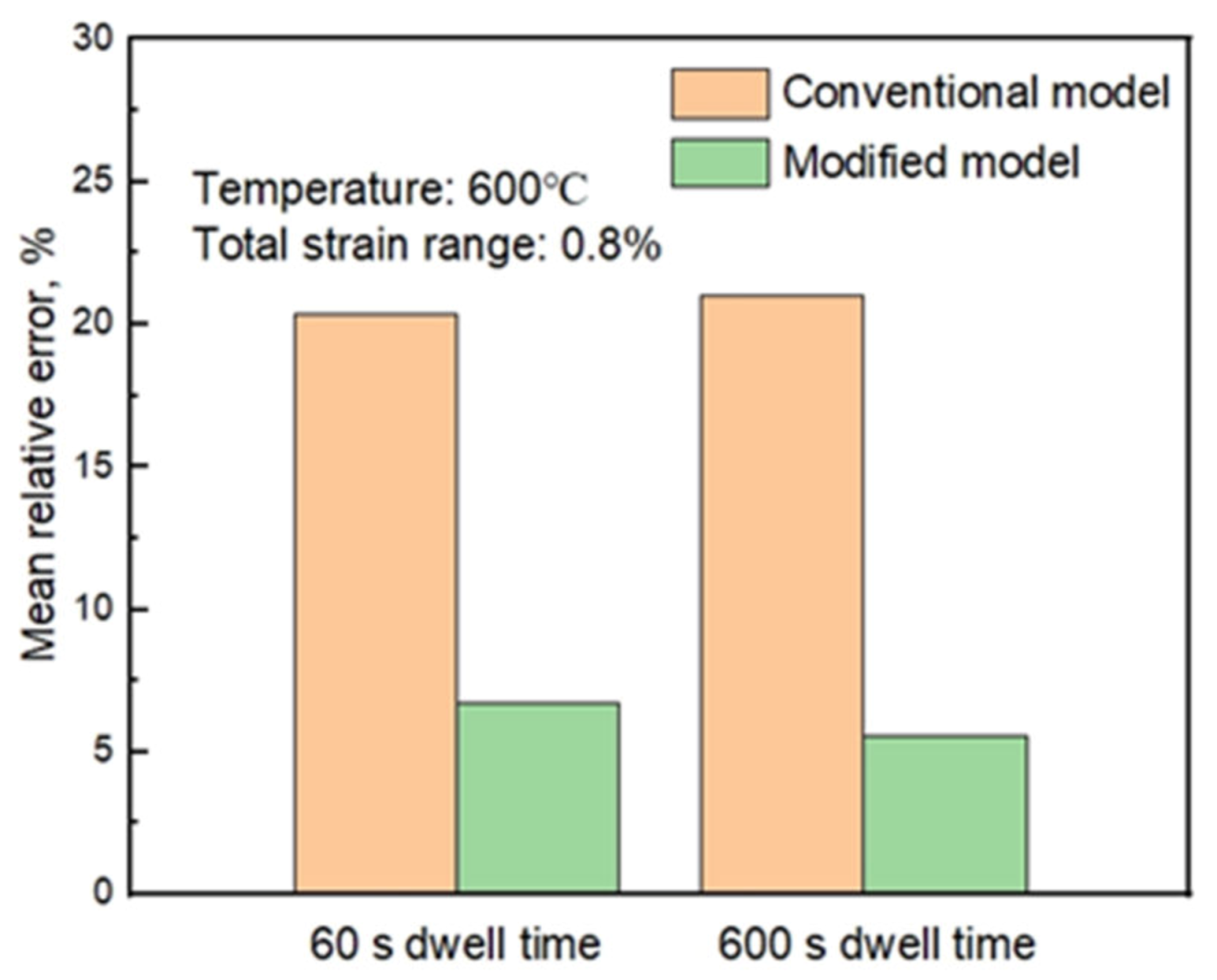
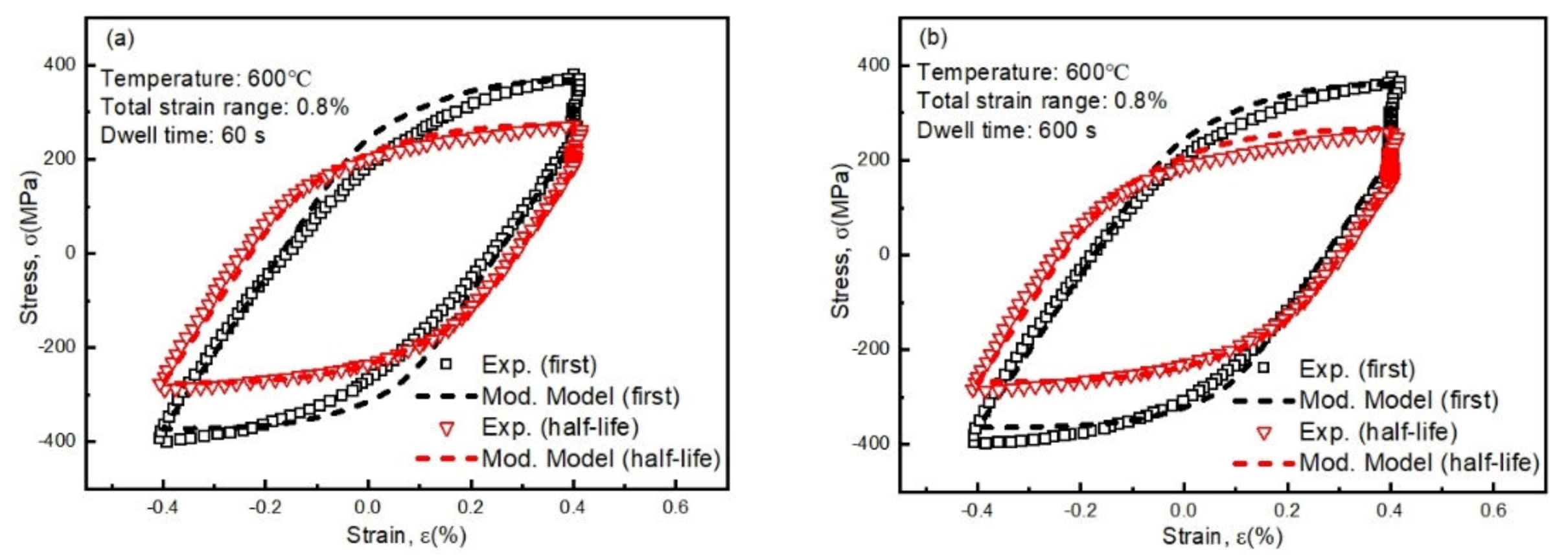

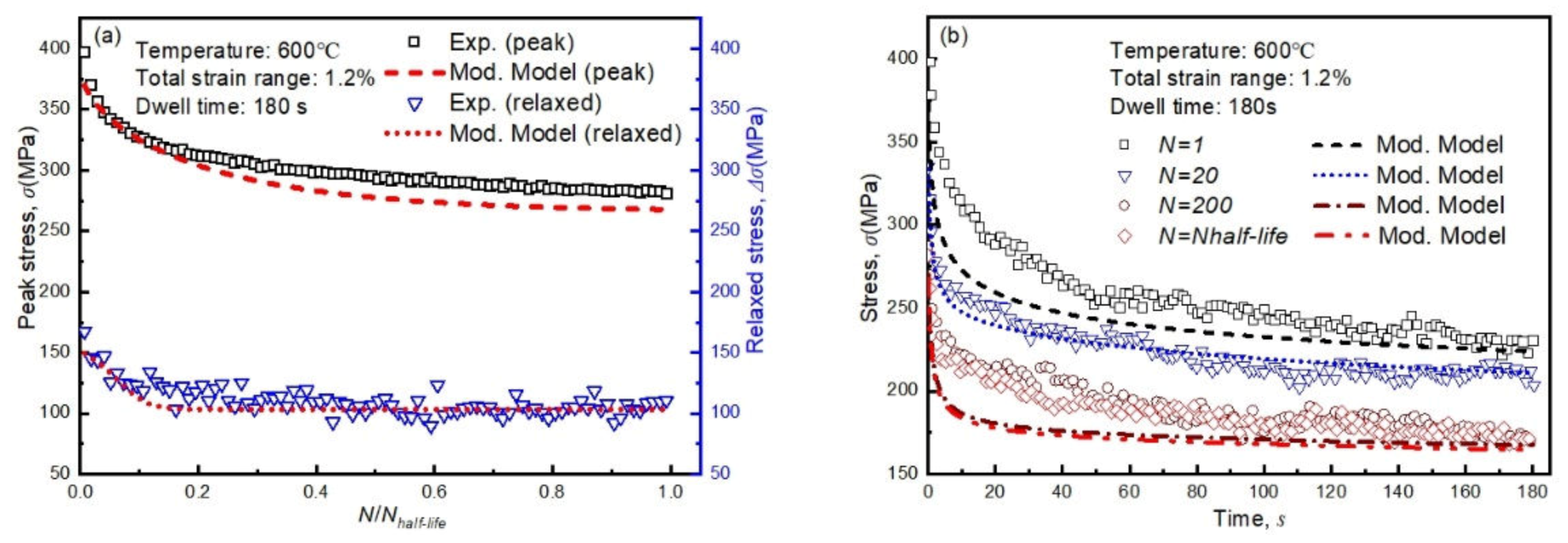
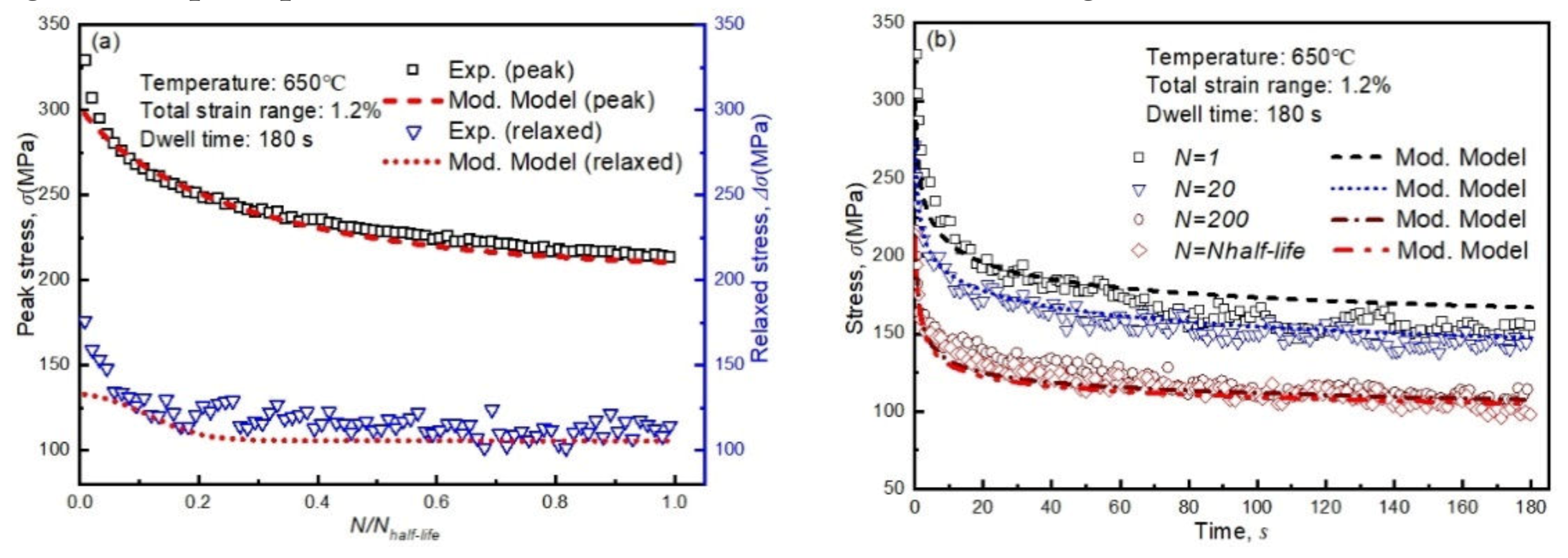
| C | Mn | Si | P | S | Cr | Mo | V | N | Ni | Al | Nb | W | B |
|---|---|---|---|---|---|---|---|---|---|---|---|---|---|
| 0.106 | 0.36 | 0.235 | 0.017 | 0.008 | 9.2 | 0.368 | 0.182 | 0.061 | 0.108 | 0.0059 | 0.078 | 1.85 | 0.0022 |
| Test No. | Temperature, T | Total Strain Range, ε | Dwell Time, th | Fatigue Life, Nf |
|---|---|---|---|---|
| 1 | 600 °C | 0.8% | 60 s | 1303 |
| 2 | 0.8% | 180 s | 1190 | |
| 3 | 0.8% | 600 s | 675 | |
| 4 | 1.2% | 180 s | 541 | |
| 5 | 650 °C | 0.8% | 60 s | 870 |
| 6 | 0.8% | 180 s | 853 | |
| 7 | 0.8% | 600 s | 625 | |
| 8 | 1.2% | 180 s | 482 |
| (1) | |
| (2) | |
| (3) | |
| (4) | |
| (5) | |
| (6) | |
| (7) | |
| (8) |
| T = 600 °C |
|---|
| E = 161,933.00 MPa, k = 180.00 MPa; |
| Q = −111.06 MPa, b = 0.81, H = −4.00 MPa, Qr = −105.74 MPa, = 2.14 × 10−8, |
| = 2.01 × 10−8, |
| r = 5.98, mr = 2.80; |
| a1 = 27.05 MPa, C1 = 25,000.00, a2 = 72.39 MPa, C2 = 996.97, γ1 = 3.00 × 10−9, γ2 = 7.47 × 10−7, |
| q = 10.00, m = 3.87; |
| Z = 1028.00 MPa·s1/n, n = 3.00 |
| T = 650 °C |
| E = 134,573.00 MPa, k = 132.00 MPa; |
| Q = −93.31 MPa, b = 0.66, H = −4.00 MPa, Qr = −86.67 MPa, = 1.93 × 10−8, |
| = 9.22 × 10−8, |
| r = 1.05, mr = 2.46; |
| a1 = 9.89 MPa, C1 = 24,685.10, a2 = 49.87 MPa, C2 = 1055.00, γ1 = 1.00 × 10−8, γ2 = 2.00 × 10−6, |
| q = 5.80, m = 3.90; |
| Z = 700.00 MPa·s1/n, n = 3.80 |
© 2020 by the authors. Licensee MDPI, Basel, Switzerland. This article is an open access article distributed under the terms and conditions of the Creative Commons Attribution (CC BY) license (http://creativecommons.org/licenses/by/4.0/).
Share and Cite
Zhang, T.; Wang, X.; Zhang, W.; Hassan, T.; Gong, J. Fatigue–Creep Interaction of P92 Steel and Modified Constitutive Modelling for Simulation of the Responses. Metals 2020, 10, 307. https://doi.org/10.3390/met10030307
Zhang T, Wang X, Zhang W, Hassan T, Gong J. Fatigue–Creep Interaction of P92 Steel and Modified Constitutive Modelling for Simulation of the Responses. Metals. 2020; 10(3):307. https://doi.org/10.3390/met10030307
Chicago/Turabian StyleZhang, Tianyu, Xiaowei Wang, Wei Zhang, Tasnim Hassan, and Jianming Gong. 2020. "Fatigue–Creep Interaction of P92 Steel and Modified Constitutive Modelling for Simulation of the Responses" Metals 10, no. 3: 307. https://doi.org/10.3390/met10030307





